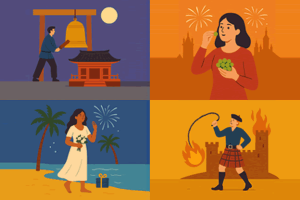 New Year’s Eve is more than just a change of calendars; it serves as a cultural reflection that embodies centuries of beliefs, traditions, and hopes. Around the globe, people mark the transition into a new year with rituals rich in symbolism, shaped by history, religion, and local identity. Here, we take a look at how different cultures interpret and celebrate NYE, revealing both universal hopes and unique customs.
New Year’s Eve is more than just a change of calendars; it serves as a cultural reflection that embodies centuries of beliefs, traditions, and hopes. Around the globe, people mark the transition into a new year with rituals rich in symbolism, shaped by history, religion, and local identity. Here, we take a look at how different cultures interpret and celebrate NYE, revealing both universal hopes and unique customs.
Japan’s New Year’s Eve Customs and Symbolism
Traditional customs: Ōmisoka, or New Year’s Eve, is spent cleaning the house, repaying debts, and purifying life from the past year. Families gather for toshikoshi soba, a long noodle dish representing longevity.
Symbolic meanings: Letting go of the old and welcoming renewal.
Celebratory practices: Buddhist temples ring bells 108 times to cleanse the soul of earthly desires.
Historical background: Rooted in Shinto and Buddhist traditions.
Regional variations: Urban areas combine tradition with Western-style countdowns and fireworks.
Spain’s NYE Rituals: Grapes, Luck, and Midnight Traditions
Traditional customs: Eating 12 grapes at midnight—one for each chime of the clock.
Symbolic meanings: Each grape represents luck and prosperity for each month.
Celebratory practices: Parties, fireworks, and music fill town squares and homes.
Historical background: Originated in the early 20th century as a light-hearted tradition.
Regional variations: In Catalonia, red underwear is worn for love and luck.
Brazil’s New Year’s Eve Beach Celebrations and Spiritual Offerings
Traditional customs: People wear white and gather on beaches, offering flowers to Yemanjá, the goddess of the sea.
Symbolic meanings: White signifies peace; offerings to deities bring blessings.
Celebratory practices: Massive seaside parties, samba music, fireworks, and jumping seven waves for luck.
Historical background: A blend of African, Catholic, and Indigenous spiritual traditions.
Regional variations: Afro-Brazilian rituals are especially vibrant in Salvador and Rio.
Scotland’s NYE Hogmanay: Fire, Songs, and First-Footing
Traditional customs: Hogmanay includes first-footing, where the first guest after midnight brings gifts.
Symbolic meanings: The “first foot” sets the tone for the year—dark-haired men bring luck.
Celebratory practices: Torch-lit parades, whisky toasts, singing Auld Lang Syne.
Historical background: Rooted in Norse and Gaelic winter solstice traditions.
Regional variations: Stonehaven’s fireball festival is a dramatic display of ancient customs.
South Africa’s New Year’s Eve Parties and Letting Go of the Past
Traditional customs: In some cities, old furniture is thrown out of windows as a symbol of letting go.
Symbolic meanings: Discarding the burdens of the past year.
Celebratory practices: Street parties, drumming, fireworks, and festive braais (BBQs).
Historical background: Blended Indigenous, colonial, and modern traditions post-Apartheid.
Regional variations: Johannesburg’s inner city is known for its extreme “out with the old” celebrations.
China’s Growing NYE Celebrations Amid Lunar Traditions
Note: Lunar New Year is the major celebration, but Western NYE is growing
Traditional customs: In major cities, NYE may involve fireworks and family dinners.
Symbolic meanings: For many, it’s a modern celebration of hope and global connection.
Celebratory practices: These increasingly include concerts and Western-style countdowns.
Historical background: Gregorian NYE adopted alongside Lunar traditions in urban centres.
Regional variations: Coastal cities are more likely to celebrate than rural areas.
Global NYE Customs: A Blend of Traditions and Modern Festivities
With the spread of Western media, urbanisation, and tourism, traditional NYE customs have blended with global trends. The midnight countdown, fireworks, and champagne are now nearly universal. Yet, many cultures continue to preserve meaningful rituals—sometimes in modified forms. From Japanese temples to Brazilian beaches, the balance between modern spectacle and cultural continuity defines today’s NYE.